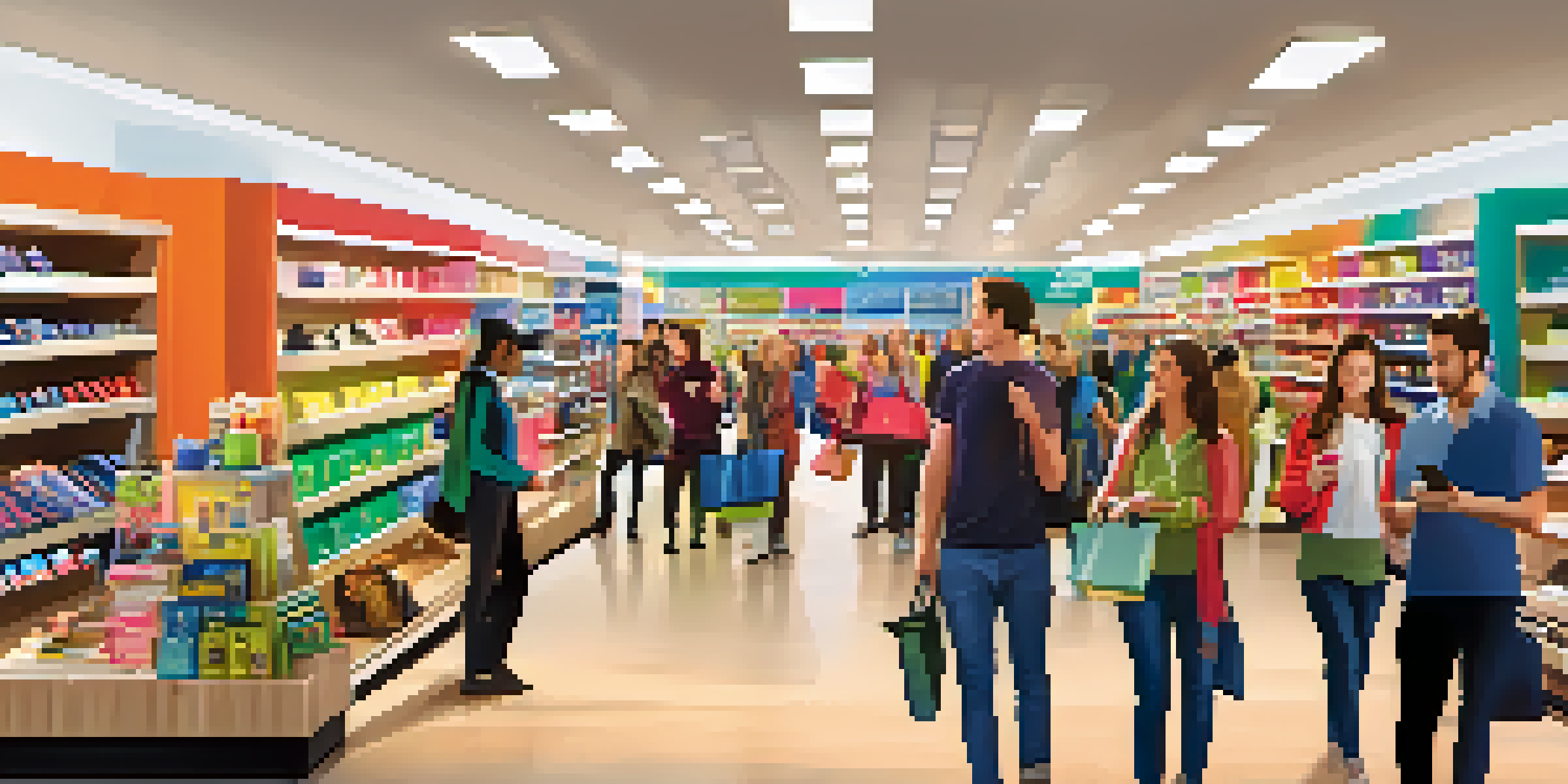How Mobile Commerce is Changing Retail: Key Insights

The Rise of Mobile Commerce in Retail
Mobile commerce, or m-commerce, is rapidly changing how we shop. With smartphones in nearly every pocket, consumers are using their devices to browse and buy products like never before. This shift is not just a trend; it's a fundamental change in retail that businesses must adapt to.
Mobile commerce is not just a trend; it’s a fundamental change in retail that businesses must adapt to.
According to recent studies, over 70% of online shoppers have made purchases through their mobile devices. This statistic highlights the growing reliance on smartphones for shopping, which has prompted retailers to enhance their mobile platforms. It’s not just about having a mobile-friendly website; it’s about creating an engaging shopping experience.
Retailers that embrace m-commerce are finding new opportunities to connect with customers. From personalized recommendations to targeted ads, mobile commerce allows for a more tailored shopping experience that can drive sales and customer loyalty.
Enhanced Customer Experience Through Apps
Mobile apps are becoming a cornerstone of retail strategy, providing a seamless shopping experience. With features like one-click purchasing and easy navigation, apps keep customers engaged and encourage repeat visits. Think of a well-designed app as a personal shopping assistant that’s always in your pocket.

Retailers can leverage push notifications to alert users about special offers or new arrivals directly on their phones. This instant communication fosters a sense of urgency and keeps the brand top-of-mind for consumers. For example, a local coffee shop can remind you about your favorite drink on a chilly morning.
Mobile Commerce Is Reshaping Retail
With over 70% of online shoppers making purchases via mobile devices, retailers must adapt to this significant shift in consumer behavior.
Moreover, apps often integrate loyalty programs, making it easier for customers to earn rewards as they shop. This not only enhances customer satisfaction but also encourages ongoing engagement with the brand.
Social Media and Mobile Commerce Interconnectedness
Social media platforms are now pivotal in driving mobile commerce. With billions of users scrolling through feeds daily, retailers can showcase their products in a visually appealing way. Platforms like Instagram and Facebook have introduced shopping features that allow users to shop directly through their posts.
The future of retail is mobile; the integration of technology will shape how we shop and interact with brands.
This integration creates a unique shopping experience where consumers can discover products organically. A well-placed ad or a trending hashtag can lead to instant sales, blurring the lines between social networking and shopping. Imagine seeing a stylish outfit on a friend’s profile and being able to purchase it with just a tap.
Furthermore, user-generated content, like reviews and photos, enhances trust and encourages purchases. When potential buyers see real people using a product, it builds credibility and can significantly influence their buying decisions.
Payment Innovations Driving Mobile Commerce Growth
Innovative payment solutions are essential for the growth of mobile commerce. Services like digital wallets, Apple Pay, and Google Wallet allow for quick and secure transactions, reducing friction during the purchasing process. This convenience is crucial, as consumers are more likely to complete a purchase when the payment process is seamless.
Additionally, advancements in security technology have made consumers feel more comfortable shopping online. Features like biometric authentication ensure that personal information is protected, building trust between retailers and consumers.
Apps Enhance Shopping Experience
Mobile apps provide seamless shopping experiences with features like one-click purchasing and loyalty programs, keeping customers engaged and encouraging repeat visits.
As mobile payment methods continue to evolve, retailers must stay updated with these trends. By offering diverse payment options and ensuring security, businesses can cater to a wider audience and increase sales.
The Role of Personalization in Mobile Shopping
Personalization is a game-changer in mobile commerce, as it helps retailers tailor the shopping experience to individual preferences. By analyzing user data, retailers can recommend products that align with a shopper's interests, making the buying process more enjoyable. Think of it as walking into a store where the staff already knows your preferences.
For instance, if a customer frequently buys athletic wear, the app could highlight new arrivals in that category or suggest complementary products. This targeted approach not only boosts sales but also enhances customer satisfaction and loyalty.
Moreover, personalized marketing campaigns through SMS or app notifications can significantly influence purchasing decisions. When customers receive tailored promotions, they’re more likely to engage with the brand and make a purchase.
The Importance of Mobile Optimization
With mobile commerce on the rise, optimizing websites for mobile devices is no longer optional—it's essential. A mobile-optimized site ensures fast loading times, easy navigation, and an overall positive user experience. If a website is slow to load or difficult to navigate on a phone, potential customers are likely to abandon their shopping journey.
Responsive design plays a crucial role in this optimization, allowing websites to adapt to different screen sizes seamlessly. This means that whether a customer is using a smartphone, tablet, or desktop, they’ll have a consistent and enjoyable experience.
Personalization Drives Sales Growth
By leveraging user data for personalized recommendations and marketing, retailers can significantly enhance customer satisfaction and boost sales.
Additionally, search engines prioritize mobile-friendly sites in their rankings, which means that businesses that invest in mobile optimization will likely see improved visibility and traffic. It’s a win-win situation that can lead to higher conversion rates.
Challenges Retailers Face in Mobile Commerce
Despite the numerous advantages of mobile commerce, retailers face several challenges. First, competition is fierce, with countless brands vying for consumer attention on mobile devices. Standing out in a crowded marketplace requires innovative strategies and compelling marketing.
Another hurdle is the potential for cart abandonment. Many shoppers add items to their carts but fail to complete the purchase, often due to a complicated checkout process. Retailers must streamline this process to reduce friction and encourage conversions.

Lastly, keeping up with rapidly changing technology and consumer preferences can be daunting. Retailers need to stay agile and continuously adapt their mobile strategies to remain relevant and meet customer expectations.
The Future of Mobile Commerce in Retail
Looking ahead, the future of mobile commerce in retail is promising. As technology continues to advance, we can expect even more innovative features that enhance the shopping experience. Augmented reality (AR), for instance, could allow customers to virtually try on clothes or see how furniture fits in their space before making a purchase.
Moreover, the integration of AI-driven chatbots can provide instant customer support, answering queries and assisting with purchases. This level of service can significantly improve customer satisfaction and streamline the shopping process.
As mobile commerce evolves, retailers that embrace these changes and prioritize customer experience will thrive. The key will be to stay informed about trends and technologies, ensuring they meet the ever-changing needs of consumers.